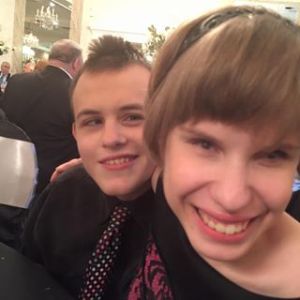Part Two of Ali Krage’s Movie Post: “I’d never done that on my own before, and neither had Joe”
January 5, 2018 • 11 Comments • Posted in blindness, guest blog, technology for people who are blindWednesday’s guest post by Ali Krage explained how she and her boyfriend make their way to their favorite movie theater, now she’s back to tell you how they liked the show!
by Alicia Krage

Alicia (left) and Joe (right)
We’d arrived very early at the theater, so we had time to sit in our seats, talk for a while and munch on our popcorn. It was about ten minutes before showtime when Joe decided we didn’t have enough popcorn to make it through the movie. He insisted we needed a refill.
I’d never done that on my own before, and neither had Joe.
The two of us spent a good five minutes bantering back and forth about how to make this happen, who was going to go get the refill, did either of us remember exactly where the concession stand was, should we go together, or does one of us need to stay back to save our seats.
And then, all of a sudden, I got this idea. I still had the number we called from the bus on our way there. How about we call them? By then the previews (not movie previews, but the weird entertainment stuff they have beforehand) had already started. Would anyone be around to answer? Even if they did, these previews are loud, would they even hear us over the phone? If they answer, what should we ask for? How could they help us? Who should make the phone call? Me? Or Joe? And do we really, really need a refill?
What can I say? My boyfriend is very persistent. So I called the theater and explained what seats we were in. “We’re both blind,” I explained. “And we need assistance.”
The voice on the phone was the same friendly voice I heard when I called earlier from the bus on our way to the theater. And you know what? It worked! Within a few minutes someone was there and more than happy to refill our popcorn for us.
Now, let’s get to the movie. I can confidently say now it is one of my all-time favorites, but don’t worry: there are no spoilers.
In case you didn’t know, though, this movie is based on a novel called Wonder. It was written by R.J. Palacio and tells the story of August Polman, a boy who was born with facial differences. Augie had been homeschooled up until fifth grade, so in the movie he was starting public school for the first time.
The audio description Joe and I listened to in our headsets during the movie was amazing — they even described what Augie’s face looks like. While watching the movie I felt very fortunate that I was never bullied in school for being blind. But Wonder is not just about looks. It’s an inspirational film about accepting who you are, and accepting others, too. Nobody is perfect, and we need to see beneath the surface.
I was so moved by the movie that I was actually crying when the employee came to escort us out when it was over. Joe took the employee’s arm, I took Joe’s hand, and off we went.
As the three of us exited the theater side-by-side-by-side, the employee asked, “Did you enjoy the movie?” The humor in his voice told me he’d noticed I was crying. I smiled and wiped my eyes. “I did!” I said, a little embarrassed by my tears. “It was my second time seeing it. Have you seen it?”
By then I was back to my enthusiastic self — although I’m sure my face didn’t look very enthusiastic. He said he hadn’t seen it yet, and I recommended it to him. I love chatting with people as they’re guiding me (or both of us, in this case). I don’t like to walk in silence.
While Joe and I waited for our bus home, he kept talking about how much he loved the movie, but of course he also took up right where the theater employee had left off, teasing me about crying during the film. All in all, though? It was a wonderful experience!
This post was originally published on the Easterseals National blog, where you can find these other great posts from Alicia:
How One Student Who is Blind Planned the Perfect Date
“Dating someone who is blind is honestly not as hard as it sounds”


